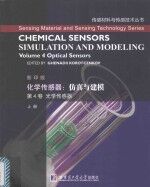图书介绍
传感材料与传感技术丛书 化学传感器:仿真与建模 第4卷 光学传感器 上:影印版pdf电子书版本下载

- (摩尔)科瑞特森科韦主编 著
- 出版社: 哈尔滨:哈尔滨工业大学出版社
- ISBN:9787560349060
- 出版时间:2015
- 标注页数:226页
- 文件大小:38MB
- 文件页数:258页
- 主题词:化学传感器-研究-英文;光敏传感器-研究-英文
PDF下载
下载说明
传感材料与传感技术丛书 化学传感器:仿真与建模 第4卷 光学传感器 上:影印版PDF格式电子书版下载
下载的文件为RAR压缩包。需要使用解压软件进行解压得到PDF格式图书。建议使用BT下载工具Free Download Manager进行下载,简称FDM(免费,没有广告,支持多平台)。本站资源全部打包为BT种子。所以需要使用专业的BT下载软件进行下载。如 BitComet qBittorrent uTorrent等BT下载工具。迅雷目前由于本站不是热门资源。不推荐使用!后期资源热门了。安装了迅雷也可以迅雷进行下载!
(文件页数 要大于 标注页数,上中下等多册电子书除外)
注意:本站所有压缩包均有解压码: 点击下载压缩包解压工具
图书目录
1 ATOMISTIC SIMULATION OF HIERARCHICAL NANOSTRUCTURED MATERIALS FOR OPTICAL CHEMICAL SENSING 1
A.Bagaturgants 1
M.Alfimov 1
1 Introduction 1
2 Hierarchical Nanomaterials:Construction and Organization Principles;Materials Construction by the Bottom-Up Principle 3
2.1 Hierarchical Nanomaterials for Nanophotonics and Their Sensing Potentialities 3
2.2 Space-Time Scale Hierarchy and the Structure of Nanomaterials for Nanophotonics 5
2.3 Structure of Nanomaterials for Optical Chemical Sensors:From a Molecule to a Supramolecular Center,Nanoparticle,and Nanomaterial 6
3 Hierarchy of Atomistic Simulation Methods Corresponding to Scale Hierarchy 8
4 Atomistic Multiscale Simulation of Hierarchical Nanomaterials for Optical Chemical Sensors:Step by Step 10
4.1 Supramolecular Level:Calculations of Molecular Interactions between Gas-Phase Analyte Molecules and Simple Substrate Models 10
4.2 Supramolecular Level:DFT Calculations of the 9-Diphenylaminoacridine(9-DPAA)Fluorescent Indicator and Its Interactions with Analyte Molecules 12
4.3 Multiscale Level:MD/DFT Slab Modeling of the Adsorption of Simple Organic and Inorganic Molecules on an Amorphous Silica Surface 17
4.4 Multiscale Level:MD/DFT Cluster Modeling of a 9-DPAA/Silica RC and Its Interaction with Small Analyte Molecules 20
4.5 Multiscale Level:MD/DFT Cluster Modeling of the Effect of Analyte Molecules on the Absorption and Fluorescence Spectra of a 9-DPAA/Silica RC 23
4.6 Multiscale Level:Modeling the Structure and Spectra of an RC Based on the Nile Red Dye Adsorbed on the Surface of Polystyrene 26
5 Prospects and Outlook 30
Acknowledgments 30
References 31
2 SELF-ASSEMBLING AND MODELING OF SENSING LAYERS:PHOTONIC CRYSTALS 39
S.Belousov 39
I.Polishchuk 39
B.Potapkin 39
1 Introduction 39
2 Photonic Crystals 41
3 Methods of Modeling Spontaneous Emission Modification 42
3.1 Correspondence Principle 43
3.2 Dipole Near a Surface 43
3.3 Modeling the Modification of Spontaneous Emission Based on the Finite-Difference Time-Domain Method 52
4 Conclusion 64
References 65
3 OPTICAL SENSING BY METAL OXIDE NANOSTRUCTURES:PHENOMENOLOGY AND BASIC PROPERTIES 71
S.Lettieri 71
1 Introduction 71
2 Optochemical Sensing by Oxide Materials:Methods Not Based on Photoluminescence 74
2.1 Approaches to Optical Sensing 74
2.2 Oxide-Based Optochemical Sensing Using Absorbance Responses 75
2.3 Oxide-Based Optochemical Sensing Using Refractive Responses 80
3 Photoluminescence-Based Optochemical Sensing by Semiconducting Materials:Models 85
3.1 Basic Principles of Photoluminescence 86
3.2 Main Processes Contributing to Photoluminescence 88
3.3 Models for Gas-Induced Photoluminescence Quenching 91
3.4 Practical Issues in Analysis and Interpretation of PL Quenching Data 97
4 Photoluminescence-Based Optochemical Sensing by Oxide Nanocrystals and Nanostructures:Results and Interpretations 101
4.1 Why Nanostructures?The Roles of Crystal Order and Size 102
4.2 Zinc Oxide Nanostructures 105
4.3 Silica Nanostructures 111
4.4 Tin Dioxide Nanostructures 116
5 Conclusions 130
Acknowledgments 132
References 132
4 SIMULATION AND MODELING OF HYDROGEN LEAK SENSORS BASED ON OPTICAL FIBER GRATINGS 141
C.Caucheteur 141
M.Debliquy 141
G.Ravet 141
D.Lahem 141
P.Megret 141
1 Introduction 141
2 Fundamentals of Fiber Gratings 144
3 Hydrogen Leak Sensor in Nitrogen Environment Using FBG Covered by Palladium 147
3.1 Axial Strain Effect 149
3.2 Temperature Effect 151
4 Hydrogen Leak Sensor in Air Environment Using FBG Covered by Tungsten Oxide Doped with Platinum 151
4.1 Reaction on the Fiber 153
4.2 Convection Losses 157
4.3 Radiation Losses 158
4.4 Conduction Losses Along the Axis of the Fiber 159
4.5 Sum of the Various Contributions 159
4.6 Simulation Results 160
5 Conclusions 163
References 163
5 SIMULATION AND MODELING OF SURFACE PLASMON RESONANCE-BASED FIBER OPTICAL SENSORS 165
Banshi D.Gupta 165
Rajan Jha 165
l Introduction and Historical Background of Surface Plasmons 165
2 Excitation of Surface Plasmons and Coupling Techniques 169
2.1 Prism Coupling 169
2.2 Waveguide Coupling 171
2.3 Grating Coupling 172
3 N-Layer Model for Different Configurations 172
3.1 Prism-Based Angular Interrogation 172
3.2 Fiber-Based Wavelength Interrogation 174
4 Sensing Principle of SPR:Performance Parameters 178
5 Fiber Optic SPR Sensors 180
5.1 Fiber Core 180
5.2 Metal Layer 181
5.3 Sensing Medium 181
6 Evolution of Fiber Optic SPR Sensors 181
7 Other Probes:Sensitivity Enhancement 182
7.1 Doped Optical Fiber Probe 182
7.2 Tapered Optical Fiber Probe 184
7.3 U-Shaped Optical Fiber Probe 188
7.4 Long-Range Surface Plasmon Resonance 189
8 Summary 191
Acknowledgment 191
References 191
6 FIBER OPTIC SENSOR OPERATING IN A MICROFLUIDIC DEVICE:A FINITE-ELEMENT ANALYSIS 197
G.Louarn 197
M.Kanso 197
T.Makiabadi 197
1 Introductjon 197
2 Theory—Governing Equations 200
2.1 General Considerations 200
2.2 Navier-Stokes Equations 201
2.3 Laminar Flow between Fixed Parallel Plates 203
2.4 Diffusion-Advection Equations in a Microfluidic Channel 204
2.5 Biochemical Reaction and Langmuir Adsorption Model 206
2.6 Surface Plasmon Resonance Absorption 209
3 Finite-Element Modeling 212
4 Quantification of the Reaction by SPR 214
5 Experimental Procedure 216
6 Numerical Results 217
7 Conclusion 223
References 224
INDEX 489